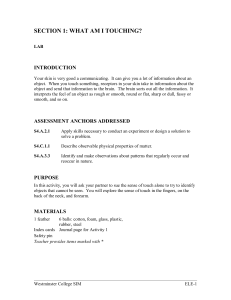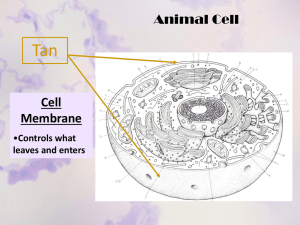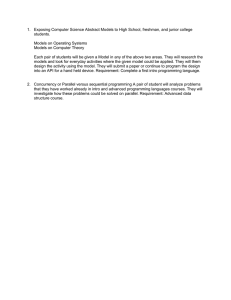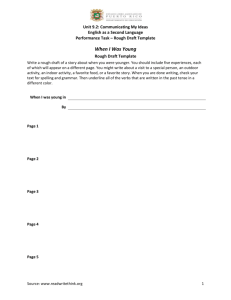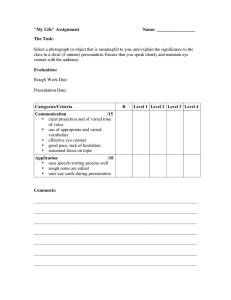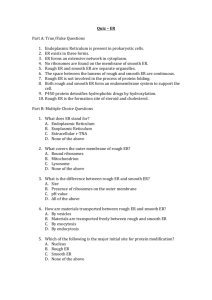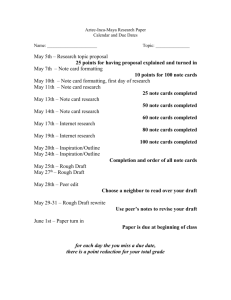Strands of MORSE and MathStats University of Warwick Wilfrid Kendall 8th May 2010
advertisement
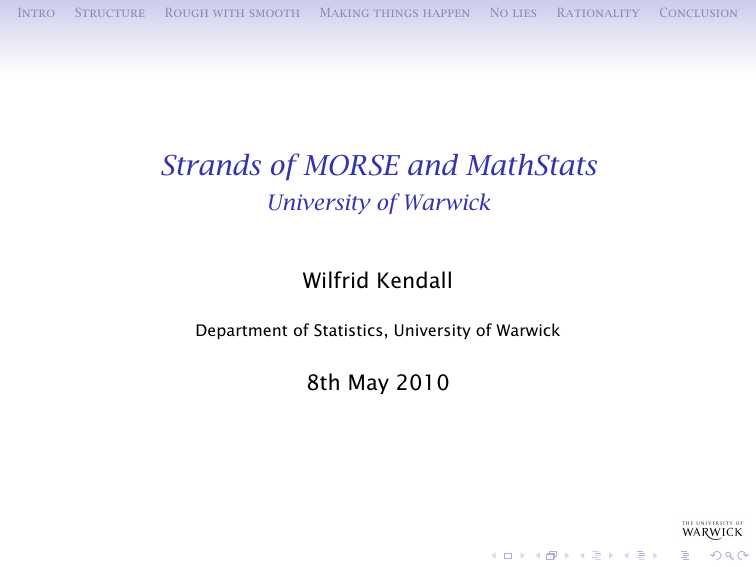
Intro Structure Rough with smooth Making things happen No lies Rationality Strands of MORSE and MathStats University of Warwick Wilfrid Kendall Department of Statistics, University of Warwick 8th May 2010 Conclusion Intro Structure Rough with smooth Making things happen No lies Rationality Conclusion Introduction MORSE, Mathematics & Statistics • Mathematics: precise calculation, artful approximation, accurate argument; • Operational Research: the application of mathematics to Business Studies; • Statistics: using mathematics to understand and to deal with uncertainty; • Economics: figuring out cooperation and conflict. Intro Structure Rough with smooth Making things happen No lies Rationality Conclusion Degree structure Our MORSE/MMORSE and MathStats/MMathStats degree courses have three aims: 1. to stimulate interest in mathematical concepts particularly in OR, Statistics, and Economics; 2. to improve the quality and quantity of people working, researching, and teaching in these areas; 3. to satisfy the needs of students who seek a continuous development of mathematics from school through university to postgraduate application. Intro Structure Rough with smooth Making things happen No lies Rationality Conclusion Degree structure Our philosophy for achieving this: • Depth: the first two years are spent on laying down strong methodological foundations in mathematics, operational research, economics, and statistics; Intro Structure Rough with smooth Making things happen No lies Rationality Conclusion Degree structure Our philosophy for achieving this: • Depth: the first two years are spent on laying down strong methodological foundations in mathematics, operational research, economics, and statistics; • Flexibility: based on these strong foundations, the remaining years allow a very wide range of choice. Intro Structure Rough with smooth Making things happen No lies Rationality Degree structure: MORSE/MMORSE Conclusion Intro Structure Rough with smooth Making things happen No lies Rationality Degree structure: MathStats/MMathStats Conclusion Intro Structure Rough with smooth Making things happen No lies Rationality Conclusion Plan I am going to talk briefly about each of the various strands of MORSE/MMORSE and MathStats/MMathStats: mathematics, operational research, statistics (both A, B and C), and economics. For each strand I am going to sketch a big idea in the area, and indicate how students learn more about the idea as they progress through their degree. Intro Structure Rough with smooth Making things happen No lies Rationality Maths: A Medieval Quote For the things of this world cannot be made known without a knowledge of mathematics. Roger Bacon: Opus Majus part 4 Distinctia Prima cap 1, 1267. Conclusion Intro Structure Rough with smooth Making things happen No lies Rationality Conclusion Maths: Taking the rough with the smooth Mathematics: • Right from the start, undergraduate mathematics works through the fundamental concepts with great care. • Reason: modern developments and applications often require the use of mathematical concepts in non-standard situations. • So it is vital to understand these concepts well enough to see how to generalize them in a way which leads to reliable applications. Intro Structure Rough with smooth Making things happen No lies Rationality Conclusion Example: calculus • Calculus: one of the most important computational tools ever; Intro Structure Rough with smooth Making things happen No lies Rationality Conclusion Example: calculus • Calculus: one of the most important computational tools ever; • Based on approximation of smooth curves by straight lines (the slope of the line is the derivative). Intro Structure Rough with smooth Making things happen No lies Rationality Conclusion Example: calculus • Calculus: one of the most important computational tools ever; • Based on approximation of smooth curves by straight lines (the slope of the line is the derivative). • Thus x 2 , 2x: Intro Structure Rough with smooth Making things happen No lies Rationality Conclusion Example: calculus • Calculus: one of the most important computational tools ever; • Based on approximation of smooth curves by straight lines (the slope of the line is the derivative). • Thus x 2 , 2x: (zooming in) Intro Structure Rough with smooth Making things happen No lies Rationality Conclusion Example: calculus • Calculus: one of the most important computational tools ever; • Based on approximation of smooth curves by straight lines (the slope of the line is the derivative). • Thus x 2 , 2x: (zooming in more) Intro Structure Rough with smooth Making things happen No lies Rationality Conclusion Example: calculus • Calculus: one of the most important computational tools ever; • Based on approximation of smooth curves by straight lines (the slope of the line is the derivative). • Thus x 2 , 2x: (zooming in still more) Intro Structure Rough with smooth Making things happen No lies Rationality Conclusion Example: calculus • Calculus: one of the most important computational tools ever; • Based on approximation of smooth curves by straight lines (the slope of the line is the derivative). • Thus x 2 , 2x: (zooming in even more) Intro Structure Rough with smooth Making things happen No lies Rationality Conclusion Example: calculus • Calculus: one of the most important computational tools ever; • Based on approximation of smooth curves by straight lines (the slope of the line is the derivative). • Thus x 2 , 2x: (zoomed in) Intro Structure Rough with smooth Making things happen No lies Rationality Conclusion Example: calculus • Calculus: one of the most important computational tools ever; • Based on approximation of smooth curves by straight lines (the slope of the line is the derivative). • Thus x 2 , 2x: (zoomed in) • We learn how to describe this differentiation process very carefully . . . Intro Structure Rough with smooth Making things happen No lies Rationality Conclusion Example: calculus • Calculus: one of the most important computational tools ever; • Based on approximation of smooth curves by straight lines (the slope of the line is the derivative). • Thus x 2 , 2x: (zoomed in) • We learn how to describe this differentiation process very carefully . . . and later on there is an important payoff! Intro Structure Rough with smooth Making things happen No lies Rationality Conclusion Commodity prices Classic financial problem: trading in options: how much should I pay now to have a future option to buy wheat at next year’s harvest? Intro Structure Rough with smooth Making things happen No lies Rationality Conclusion From smooth lines to rough Brownian motion • Commodity prices vary with time, but not smoothly; • Very irregular and rough variation; nothing like a smooth curve! (zooming in) Intro Structure Rough with smooth Making things happen No lies Rationality Conclusion From smooth lines to rough Brownian motion • Commodity prices vary with time, but not smoothly; • Very irregular and rough variation; nothing like a smooth curve! (zooming in more) Intro Structure Rough with smooth Making things happen No lies Rationality Conclusion From smooth lines to rough Brownian motion • Commodity prices vary with time, but not smoothly; • Very irregular and rough variation; nothing like a smooth curve! (zooming in even more) Intro Structure Rough with smooth Making things happen No lies Rationality Conclusion From smooth lines to rough Brownian motion • Commodity prices vary with time, but not smoothly; • Very irregular and rough variation; nothing like a smooth curve! (zoomed in) Intro Structure Rough with smooth Making things happen No lies Rationality Conclusion From smooth lines to rough Brownian motion • Commodity prices vary with time, but not smoothly; • Very irregular and rough variation; nothing like a smooth curve! (zoomed in) • So better approximations can be obtained using variants of Brownian motion. Intro Structure Rough with smooth Making things happen No lies Rationality Conclusion Payoff: stochastic calculus • Brownian paths are never smooth anywhere, even though they are continuous everywhere! • Nevertheless, the insights gained from a careful understanding of calculus can be carried across to model commodity prices using rough Brownian motion paths instead of smooth straight lines; this is stochastic calculus; • The careful treatment of ordinary calculus in year 1 eventually allows us to discuss stochastic calculus for the multi-trillion dollar options industry in year 4 . . . Intro Structure Rough with smooth Making things happen No lies Rationality Conclusion Payoff: stochastic calculus • Brownian paths are never smooth anywhere, even though they are continuous everywhere! • Nevertheless, the insights gained from a careful understanding of calculus can be carried across to model commodity prices using rough Brownian motion paths instead of smooth straight lines; this is stochastic calculus; • The careful treatment of ordinary calculus in year 1 eventually allows us to discuss stochastic calculus for the multi-trillion dollar options industry in year 4 . . . . . . we need in-depth understanding to figure out how it works, Intro Structure Rough with smooth Making things happen No lies Rationality Conclusion Payoff: stochastic calculus • Brownian paths are never smooth anywhere, even though they are continuous everywhere! • Nevertheless, the insights gained from a careful understanding of calculus can be carried across to model commodity prices using rough Brownian motion paths instead of smooth straight lines; this is stochastic calculus; • The careful treatment of ordinary calculus in year 1 eventually allows us to discuss stochastic calculus for the multi-trillion dollar options industry in year 4 . . . . . . we need in-depth understanding to figure out how it works, how it breaks, Intro Structure Rough with smooth Making things happen No lies Rationality Conclusion Payoff: stochastic calculus • Brownian paths are never smooth anywhere, even though they are continuous everywhere! • Nevertheless, the insights gained from a careful understanding of calculus can be carried across to model commodity prices using rough Brownian motion paths instead of smooth straight lines; this is stochastic calculus; • The careful treatment of ordinary calculus in year 1 eventually allows us to discuss stochastic calculus for the multi-trillion dollar options industry in year 4 . . . . . . we need in-depth understanding to figure out how it works, how it breaks, and how to fix it. Intro Structure Rough with smooth Making things happen No lies Rationality Conclusion Nobel Prizes! Merton and Scholes gained the Nobel Prize in Economics for 1997, for using these ideas (in collaboration with Black) to produce a formula for pricing options. Intro Structure Rough with smooth Making things happen No lies Rationality Conclusion Nobel Prizes! Merton and Scholes gained the Nobel Prize in Economics for 1997, for using these ideas (in collaboration with Black) to produce a formula for pricing options. C = √ SN (d1 ) − Le−rT N d1 − σ T Intro Structure Rough with smooth Making things happen No lies Rationality Conclusion Nobel Prizes! Merton and Scholes gained the Nobel Prize in Economics for 1997, for using these ideas (in collaboration with Black) to produce a formula for pricing options. C = √ SN (d1 ) − Le−rT N d1 − σ T From Slashdot: “Granted, the current crisis was caused by over-reliance on models, but that happened because most traders and managers did not understand the models and their limitations. To rectify that, there will be an even greater need for those trained in financial mathematics.” Intro Structure Rough with smooth Making things happen No lies Selected relevant modules 1. • MA131 Analysis • ST111/ST112 Probability 2. • ST202 Stochastic Processes • ST213 Mathematics of Random Events 3&4. • • • • ST318 ST401 ST403 ST905 Probability Theory Stochastic Methods in Finance Brownian Motion Stochastic Methods II Rationality Conclusion Intro Structure Rough with smooth Making things happen No lies Rationality Operational Research helps management achieve its goals using scientific methods OR: A matter of life and death in WW2 Bomber Command inspected all bombers returning from bombing raids over a particular period. All damage inflicted was noted and the recommendation was given that armour be added in the most heavily damaged areas. Conclusion Intro Structure Rough with smooth Making things happen No lies Rationality Operational Research helps management achieve its goals using scientific methods OR: A matter of life and death in WW2 Bomber Command inspected all bombers returning from bombing raids over a particular period. All damage inflicted was noted and the recommendation was given that armour be added in the most heavily damaged areas. Patrick Blackett’s team instead made the surprising and counter-intuitive recommendation that the armour be placed in the areas which were completely untouched by damage, according to the survey. Conclusion Intro Structure Rough with smooth Making things happen No lies Rationality Operational Research helps management achieve its goals using scientific methods OR: A matter of life and death in WW2 Bomber Command inspected all bombers returning from bombing raids over a particular period. All damage inflicted was noted and the recommendation was given that armour be added in the most heavily damaged areas. Patrick Blackett’s team instead made the surprising and counter-intuitive recommendation that the armour be placed in the areas which were completely untouched by damage, according to the survey. Blackett won the Nobel prize in Physics for 1948. Conclusion Intro Structure Rough with smooth Making things happen No lies Rationality Conclusion OR: The art and science of making things happen Business activity raises many questions which are essentially mathematical: • how best to arrange for transportation of raw materials from quarries to factories so as to minimize the expense incurred in running and maintaining lorries? • how best to schedule activities in a project so that time is not wasted by people waiting for other tasks to finish so that they can begin work on the product? • how big a warehouse is needed to hold inventories so that time is not wasted waiting for re-orders? Intro Structure Rough with smooth Making things happen No lies Rationality Conclusion Both pragmatic and theoretical Operational research (OR) concerns the identification, formulation and solution of such management problems. It ranges from the highly pragmatic (what is the best solution to this very explicit and specific problem?) to the very theoretical (is it possible to say that in some mathematical sense all problems of a certain type are very hard?). Intro Structure Rough with smooth Making things happen No lies Rationality Conclusion Travelling Salesman Problem Here is a hard kind of problem: find the shortest path which visits each of N locations. For example • this is the path taken by a travelling salesman who wishes to minimize time on the road; • it is relevant to problems in printed circuit design; The figure illustrates the solution for 15112 German villages (solution found after intensive parallel computation in 2001). Intro Structure Rough with smooth Making things happen No lies Rationality . . . and many other similar problems Example: how can a road-builder make a good trade-off between Conclusion Intro Structure Rough with smooth Making things happen No lies Rationality Conclusion . . . and many other similar problems Example: how can a road-builder make a good trade-off between (a) connecting everywhere together with routes whose lengths are as short as possible; Intro Structure Rough with smooth Making things happen No lies Rationality Conclusion . . . and many other similar problems Example: how can a road-builder make a good trade-off between (a) connecting everywhere together with routes whose lengths are as short as possible; (b) yet not putting down roads everywhere? Intro Structure Rough with smooth Making things happen No lies Rationality Conclusion . . . and many other similar problems Example: how can a road-builder make a good trade-off between (a) connecting everywhere together with routes whose lengths are as short as possible; (b) yet not putting down roads everywhere? This is a problem in frustrated optimization . . . Intro Structure Rough with smooth Making things happen No lies Rationality Conclusion . . . and many other similar problems Example: how can a road-builder make a good trade-off between (a) connecting everywhere together with routes whose lengths are as short as possible; (b) yet not putting down roads everywhere? This is a problem in frustrated optimization . . . . . . and it has a surprising random solution! Intro Structure Rough with smooth Making things happen No lies Rationality Selected relevant modules 1. 2. 3&4. • IB104 Mathematical Programming I • IB207 Mathematical Programming II • • • • IB320 IB352 IB317 IB404 Simulation Mathematical Programming III Nature and Method of Operational Research Advanced Optimization and Modelling Conclusion Intro Structure Rough with smooth Making things happen No lies Rationality Statistics and Politics “I gather, young man, that you wish to be a Member of Parliament. The first lesson that you must learn is, when I call for statistics about the rate of infant mortality, what I want is proof that fewer babies died when I was Prime Minister than when anyone else was Prime Minister. That is a political statistic.” Winston Churchill Conclusion Intro Structure Rough with smooth Making things happen No lies Rationality Statistics and Politics “I gather, young man, that you wish to be a Member of Parliament. The first lesson that you must learn is, when I call for statistics about the rate of infant mortality, what I want is proof that fewer babies died when I was Prime Minister than when anyone else was Prime Minister. That is a political statistic.” Winston Churchill Churchill won the Nobel prize in Literature for 1953 Conclusion Intro Structure Rough with smooth Making things happen No lies Rationality Statistics: Trying not to tell lies Opinion polls on eve of General Election, May 2005: % Lab Con LD (Other) Poll A 40 34 20 Poll B 40 30 22 Poll C 36 35 23 random phone 11-15/4 [1000] random phone 13-15/4 [1521] representative online 14-16/4 [1483] Conclusion Intro Structure Rough with smooth Making things happen No lies Rationality Being honest about variation Opinion polls on eve of General Election, May 2005: % Lab Con LD (Other) Poll A 40 ±3 34 ±3 20 ±2.5 Poll B 40 ±2.5 30 ±2.3 22 ±2 Poll C 36 ±2.5 35 ±2.4 23 ±2.2 random phone 11-15/4 [1000] random phone 13-15/4 [1521] representative online 14-16/4 [1483] Conclusion Intro Structure Rough with smooth Making things happen No lies Rationality Conclusion Bias can matter more than variation Concerns: • defective sampling (“track down too many Labs, not enough Cons”); • interviewer effect (some shy Con voters unwilling to admit it to stranger); • or, differential turnout. “Which of us is right? Maybe, but only maybe, we shall find out on May 6.” Peter Kellner, Sunday Times, 17 April 2005 Intro Structure Rough with smooth Making things happen 6 May 2005 Comparison with actual result: No lies Rationality Conclusion Intro Structure Rough with smooth Making things happen No lies Rationality Conclusion 6 May 2005 Comparison with actual result: % Lab Con LD (Other) Poll A 40 ±3 34 ±3 20 ±2.5 Poll B 40 ±2.5 30 ±2.3 22 ±2 Poll C 36 ±2.5 35 ±2.4 23 ±2.2 Result 35.3 32.3 22.1 random phone 11-15/4 [1000] random phone 13-15/4 [1521] representative online 14-16/4 [1483] Intro Structure Rough with smooth Making things happen No lies Rationality Conclusion Particle tracks and geology Issues of bias matter in more than just politics. Geologists find out about the his• tory of rocks by looking at tracks left by fission particles. • Particle tracks which intersect the surface of a crystal are revealed by etching. Tracks (visible by microscope) are measured by length. • Since tracks fade with time, and are destroyed by heating, the hope is that a histogram of track lengths will help geologists to describe the history of the rock (geochronology). Intro Structure Rough with smooth Making things happen No lies Rationality Conclusion What you see is biased by how you look On a first look, one sees lots and lots of fission tracks. However: • one only sees tracks which somehow intersect the surface (hence etched); so more likely to see long tracks; • in most cases one only sees a fraction of the track; Intro Structure Rough with smooth Making things happen No lies Rationality Conclusion What you see is biased by how you look On a first look, one sees lots and lots of fission tracks. However: • one only sees tracks which somehow intersect the surface (hence etched); so more likely to see long tracks; • in most cases one only sees a fraction of the track; • there are a few whole tracks, revealed because they intersect with an etched track. Intro Structure Rough with smooth Making things happen No lies Rationality Conclusion “Tracks in tracks” Turns out, the best information comes from looking at only the small number of whole tracks, and then correcting for the bias towards longer tracks. Top: “tracks in tracks”; bottom: “half-tracks”. Intro Structure Rough with smooth Making things happen No lies Rationality Conclusion Sometimes it is better to throw most of the data away! A clearer picture emerges more easily if we restrict attention to the very few “tracks in tracks”. Intro Structure Rough with smooth Making things happen No lies Rationality Conclusion From votes to rocks to health Similar issues arise in medical statistics. Examples: how do we allow for bias arising from: • patients who get better (or worse!) then choosing to drop out of a study? • different criteria being used to record health problems in different countries? • assessment of severity of an epidemic when only the worst-affected cases have been recorded? • publication bias, if medical scientists only publish when the treatment happens to work? Being careful about this involves clear thinking and clever mathematics! Intro Structure Rough with smooth Making things happen No lies Rationality Conclusion The ABC of Mathematics & Statistics Modern statistics is a rich and rapidly growing subject. Anywhere we have to deal with uncertainty, there is a place where modern statistics makes an impact. To reflect this richness, we have divided the MMathStat third/fourth years into three different streams: you will study one of Intro Structure Rough with smooth Making things happen No lies Rationality Conclusion The ABC of Mathematics & Statistics Modern statistics is a rich and rapidly growing subject. Anywhere we have to deal with uncertainty, there is a place where modern statistics makes an impact. To reflect this richness, we have divided the MMathStat third/fourth years into three different streams: you will study one of (A) Advanced statistics: an in-depth training in statistical theory and methodology for which there is a huge demand and a tremendous variety of job opportunities ranging from statistical careers in business, science, industry, or government, through to many openings arising from rapid growth in the world of finance; Intro Structure Rough with smooth Making things happen No lies Rationality Conclusion The ABC of Mathematics & Statistics Modern statistics is a rich and rapidly growing subject. Anywhere we have to deal with uncertainty, there is a place where modern statistics makes an impact. To reflect this richness, we have divided the MMathStat third/fourth years into three different streams: you will study one of (B) statistical topics in Biology and medicine: the activity here has recently exploded in scale, in response to the challenges of the science of the human genome, the search for new drug treatments, the human and biological problems of epidemics, and the complex issues of modern health care; Intro Structure Rough with smooth Making things happen No lies Rationality Conclusion The ABC of Mathematics & Statistics Modern statistics is a rich and rapidly growing subject. Anywhere we have to deal with uncertainty, there is a place where modern statistics makes an impact. To reflect this richness, we have divided the MMathStat third/fourth years into three different streams: you will study one of (C) statistics and Computation: advances in modern computing processing power and storage are opening up a huge range of developments in statistics: dealing with vast quantities of data (data-mining, data-collection by satellite); developing new statistical algorithms to use all this computational power; finding out how to analyze the performance of these algorithms. Intro Structure Rough with smooth Making things happen No lies Rationality Conclusion A short boast about Warwick Statistics EPSRC Grant Reference: EP/D002060/1 The Centre for Research in Statistical Methodology (CRISM) Principal Investigator: Professor J Copas Department: Statistics Organisation: University of Warwick Abstract: The philosophy of CRISM is that maximum impact on statistics as a whole is best served by concentrating research and training on the methodological core of the discipline, and that the best return on investment is achieved by grafting the new centre onto a department with proven excellence in methodological research linking to strong applications groups. The Warwick Department of Statistics (RAE 5*/6*) excels in all of these areas, and has an excellent track record of exploiting statistical interactions. . . . Starts: 1 October 2005 Value: UKP 4,116,561 Ends: 30 September 2013 Intro Structure Rough with smooth Making things happen No lies Rationality Conclusion A short boast about Warwick Statistics EPSRC Grant Reference: EP/D002060/1 The Centre for Research in Statistical Methodology (CRISM) Principal Investigator: Professor J Copas Department: Statistics Organisation: University of Warwick Abstract: The philosophy of CRISM is that maximum impact on statistics as a whole is best served by concentrating research and training on the methodological core of the discipline, and that the best return on investment is achieved by grafting the new centre onto a department with proven excellence in methodological research linking to strong applications groups. The Warwick Department of Statistics (RAE 5*/6*) excels in all of these areas, and has an excellent track record of exploiting statistical interactions. . . . Starts: 1 October 2005 Value: UKP 4,116,561 Ends: 30 September 2013 Intro Structure Rough with smooth Making things happen No lies Selected relevant modules 1. • ST104 Statistical Laboratory • ST111/ST112 Probability 2. • ST217 Mathematical Statistics • ST215 Forecasting and Control 3&4. • ST332 Medical Statistics • ST336 Life Tables • ST404 Applied Statistical Modelling Rationality Conclusion Intro Structure Rough with smooth Making things happen No lies Rationality Economics: a question Q: How many economists does it take to change a light bulb? Conclusion Intro Structure Rough with smooth Making things happen No lies Rationality Economics: a question Q: How many economists does it take to change a light bulb? A: None, the market will take care of it. Conclusion Intro Structure Rough with smooth Making things happen No lies Rationality Conclusion Economics: Rationality, wealth and behaviour Statistics and Economics overlap when one considers “rational behaviour”. Rather direct arguments show that: • When faced with uncertainty, “rational” people should behave as if they have assigned probabilities to uncertain events; • When asked to prioritize, “rational” people should behave as if they have assigned numerical values to their preferences for various outcomes. Intro Structure Rough with smooth Making things happen No lies Rationality Conclusion Implications This perspective allows us • to understand why it makes sense for people to insure against risk; • to understand why people buy lottery tickets; • to model uncertainty in complicated business and engineering problems; • to analyze causes of traffic congestion; • and (by taking account of the presence of many different agents, each with their own rational preferences) to make decisions about how to organize • auctions of electromagnetic spectrum; • charges for use of internet; • charges for toll roads. Intro Structure Rough with smooth Making things happen No lies Rationality Illustrative example How high should be the charge for using the M6 Toll Road? Of course the toll is set to provide a good return on private investment. However . . . . . . if the toll is set too low, usage will rise and so will congestion; . . . if the toll is set too high, usage will be too low. This kind of consideration is typical for many public goods. Conclusion Intro Structure Rough with smooth Making things happen John Nash 1994 Nobel Prize in economics. Cf “A Beautiful Mind” No lies Rationality Conclusion Intro Structure Rough with smooth Making things happen No lies The stakes are high . . . “The Tragedy of the Commons” (Garrett Hardin, Science 1968). Rationality Conclusion Intro Structure Rough with smooth Making things happen No lies Rationality Conclusion The stakes are high . . . “The Tragedy of the Commons” (Garrett Hardin, Science 1968). Consider medieval herders grazing their cows on a common piece of land (the commons). It is in each herder’s interest to put all his cows onto the land, even if the commons is then over-grazed and damaged as a result. (The herder receives the benefits; the damage to the commons is shared by all.) If all herders make this individually rational economic decision, the commons will be destroyed. Intro Structure Rough with smooth Making things happen No lies Rationality Conclusion The stakes are high . . . “The Tragedy of the Commons” (Garrett Hardin, Science 1968). Consider medieval herders grazing their cows on a common piece of land (the commons). It is in each herder’s interest to put all his cows onto the land, even if the commons is then over-grazed and damaged as a result. (The herder receives the benefits; the damage to the commons is shared by all.) If all herders make this individually rational economic decision, the commons will be destroyed. Over-fishing Pollution Internet CO2 Congestion Intro Structure Rough with smooth Making things happen No lies Rationality Conclusion The stakes are high . . . “The Tragedy of the Commons” (Garrett Hardin, Science 1968). Consider medieval herders grazing their cows on a common piece of land (the commons). It is in each herder’s interest to put all his cows onto the land, even if the commons is then over-grazed and damaged as a result. (The herder receives the benefits; the damage to the commons is shared by all.) If all herders make this individually rational economic decision, the commons will be destroyed. Over-fishing Pollution Internet CO2 Congestion Fix: Carefully arrange incentives / taxes / prices so that people start acting in common interest. Intro Structure Rough with smooth Making things happen No lies Rationality Selected relevant modules 1. • EC106 Introduction to Quantitative Economics • ST114 Games and Decisions 2. • EC220/221 Mathematical Economics 3&4. • EC301 Mathematical Economics 2 • ST301 Bayesian Statistics and Decision Theory • ST337 Bayesian Forecasting and Intervention Conclusion Intro Structure Rough with smooth Making things happen No lies Rationality Conclusion Conclusion What about the chances of getting a job afterwards? Graduate employment prospects vary from year to year: Intro Structure Rough with smooth Making things happen No lies Rationality Conclusion Conclusion What about the chances of getting a job afterwards? Graduate employment prospects vary from year to year: BBC News Wednesday 20, April 2005: Graduate gloom about job chances “Two thirds of those graduating from leading UK universities this summer believe there are not enough suitable jobs for them, a survey suggests.” Intro Structure Rough with smooth Making things happen No lies Rationality Conclusion Example: First destinations for Warwick Statistics graduates, 2004/2005 collected end-2005 Employed and Studying Employed Further study Not available Still seeking 27% 49% 6% 15% 3% Intro Structure Rough with smooth Making things happen No lies Rationality Conclusion Example: First destinations for Warwick Statistics graduates, 2004/2005 collected end-2005 Employed and Studying Employed Further study Not available Still seeking Our philosophy of depth and flexibility pays off! 27% 49% 6% 15% 3% Intro Structure Rough with smooth Making things happen No lies Rationality Conclusion Example: First destinations for Warwick Statistics graduates, 2004/2005 collected end-2005 Employed and Studying Employed Further study Not available Still seeking Our philosophy of depth and flexibility pays off! Examples: accountants, actuaries, financial analysts, statisticians, administrators, researchers, teachers, freelance radio presenter, student politician. 27% 49% 6% 15% 3% Intro Structure Rough with smooth Making things happen No lies Rationality Conclusion Example: First destinations for Warwick Statistics graduates, 2004/2005 collected end-2005 Employed and Studying Employed Further study Not available Still seeking 27% 49% 6% 15% 3% Our philosophy of depth and flexibility pays off! Examples: accountants, actuaries, financial analysts, statisticians, administrators, researchers, teachers, freelance radio presenter, student politician. Graduate employment prospects vary from year to year: but Warwick Statistics graduates have an excellent competitive advantage: they have learned to master difficult and important ideas. Intro Structure Rough with smooth Making things happen And finally . . . No lies Rationality Conclusion

